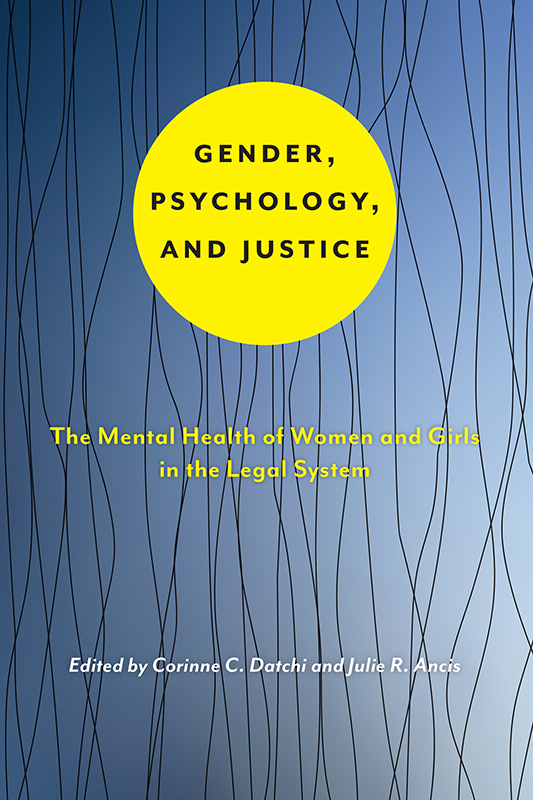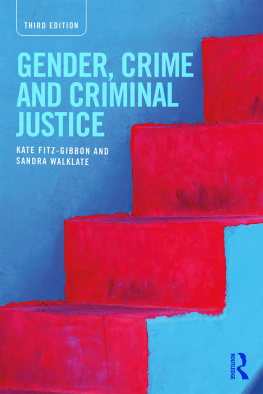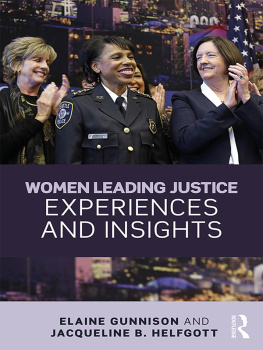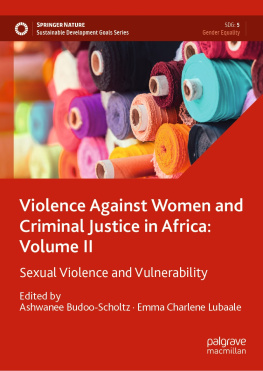
Gender, Psychology, and Justice
PSYCHOLOGY AND CRIME
General Editors: Brian Bornstein, University of Nebraska, and Monica Miller, University of Nevada, Reno
The Perversion of Youth: Controversies in the Assessment and Treatment of Juvenile Sex Offenders
Frank C. DiCataldo
Jury Decision Making: The State of the Science
Dennis J. Devine
Deviant and Criminal Behavior in the Workplace
Edited by Steven M. Elias
Psychopathy: An Introduction to Biological Findings and Their Implications
Andrea L. Glenn and Adrian Raine
Gender, Psychology, and Justice: The Mental Health of Women and Girls in the Legal System
Edited by Corinne C. Datchi and Julie R. Ancis
Gender, Psychology, and Justice
The Mental Health of Women and Girls in the Legal System
Edited by Corinne C. Datchi and Julie R. Ancis

NEW YORK UNIVERSITY PRESS
New York
NEW YORK UNIVERSITY PRESS
New York
www.nyupress.org
2017 by New York University
All rights reserved
References to Internet websites (URLs) were accurate at the time of writing. Neither the author nor New York University Press is responsible for URLs that may have expired or changed since the manuscript was prepared.
ISBN : 978-1-4798-1985-0 (hardback)
ISBN : 978-1-4798-8584-8 (paperback)
For Library of Congress Cataloging-in-Publication data, please contact the Library of Congress.
New York University Press books are printed on acid-free paper, and their binding materials are chosen for strength and durability. We strive to use environmentally responsible suppliers and materials to the greatest extent possible in publishing our books.
Manufactured in the United States of America
10 9 8 7 6 5 4 3 2 1
Also available as an ebook
Contents
Corinne C. Datchi and Julie R. Ancis
Julie R. Ancis
Lenore E. A. Walker and Carlye B. Conte
Thema Bryant-Davis, Tyonna Adams, and Anthea Gray
Corinne C. Datchi
Elizabeth A. Lilliott, Elise M. Trott, Nicole C. Kellett, Amy E. Green, and Cathleen E. Willging
Kendra R. Brewster and Kathleen M. Cumiskey
Alexis Forbes and Kevin L. Nadal
Angela Irvine, Aisha Canfield, and Jessica Roa
Erica G. Rojas, Laura Smith, and Randolph M. Scott-McLaughlin II
Anna Ochoa OLeary
Jonathan Schwartz and Jennifer Bahrman
Julie R. Ancis and Corinne C. Datchi
Gender, Psychology, and Justice is the product of collaborative efforts and a friendship that began five years ago when we, Corinne and Julie, served on the Executive Board of the Section for the Advancement of Women of the American Psychological Associations Society for Counseling Psychology. It seemed natural to work together on a project that reflected our commitment to social justice and advocacy as expressed through our research, training, and clinical practice with diverse women and girls. We shared a common interest in gender and multicultural issues and were actively engaged in research and practice in various areas of the legal system. During our respective terms as chairs of the Section for the Advancement of Women, we created initiatives related to women and girls in the justice system. We believed it was critical to more broadly call attention to the experiences of women and girls in the justice system. Because this population is often invisible to a broader public, including mental health professionals, the importance of offering not only information but also specific recommendations that addressed womens and girls unique concerns seemed crucial. This book developed from our many conversations and the enthusiasm and receptiveness of the authors who contributed to this volume.
With the support of Jennifer Hammer, our editor at NYU Press, we have increased the books capacity to raise awareness and guide a wide audience. I, Corinne, was also fortunate to receive support from Seton Hall University to focus on my responsibilities as editor. We also thank Donjae Catanzariti, a counseling psychology doctoral student at Seton Hall University, for helping us prepare the manuscript for submission.
The stories of girls and women throughout the book speak to the need for significant justice reform. We thank the courageous and resilient women who expressed their stories and the authors and advocates who engage in this work. This work requires courage and an open heart, and we acknowledge all who have demonstrated both.
Gender, Psychology, and Justice
Corinne C. Datchi and Julie R. Ancis
If one really wishes to know how justice is administered in a country, one does not question the policemen, the lawyers, the judges, or the protected members of the middle class. One goes to the unprotectedthose, precisely, who need the laws protection most!and listens to their testimony.
James Baldwin, 1985
Gender structures social interactions in ways that frequently place girls and women at a disadvantage in many justice systems across the world (United Nations Office on Drugs and Crime 2008). More specifically, gender-related norms, assumptions, stereotypes, and biases often influence womens and girls initial and repeated contact with justice officials as well as their vulnerability and victimization in legal settings. Together with racial, class, sexual, and other structural inequalities, they shape the way diverse women and girls experience justice decisions and interventions; they also determine the unique outcomes of their interactions with legal and mental health practitioners.
The American Psychological Association Guidelines for Psychological Practice with Girls and Women (APA 2007) define gender as a multilevel phenomenon: Intrapersonally, gender refers to the cognitive schemas, beliefs, and attitudes that guide individuals expression of their social identities in relational contexts. It also refers to the process whereby individuals engage in presentations of self that deviate or conform to gender norms and expectations (Butler 1999, 2004). At a macro-systemic level, gender is a societal structure that determines individuals social status and their access to resources, power, and privileges (Ayman and Korabik 2010).
The criminological literature has made visible the gendered nature of the criminal justice system. Feminist criminologists and legal scholars have well documented how gender restricts girls and womens access to equitable justice through mechanisms that are evident, tacit, or hidden. They have demonstrated that gender influences the justice systems responses to female offending and victimization (Belknap 2015; Silvestri and Crowther-Dowey 2008; Sprott, Zimring, and Doob 2009; Wykes and Welsh 2009). They have also identified the pathways that lead to girls and womens involvement with the criminal justice system, as well as the unique challenges girls and women encounter as a result of sexual and physical violence, mental health problems, unmet health-care needs, substance dependence, family responsibilities, and discrimination in employment and education (Belknap 2015; Davies 2011; Morash 2005; Van Gundy and Baumann-Grau 2013).
Feminist criminologists and legal scholars have identified the conditions that explain the unprecedented increase in womens and girls arrests and incarceration since the 1970s. These numbers have continued to rise at rates that surpass those of boys and men (Mauer 2013; Minton and Zeng 2015), although the majority of female offenders commit nonviolent crimes that do not represent a risk for public safety (e.g., stealing, running away, violating court orders). Changes in policiesrather than changes in behaviorsexplain why increasingly more women and girls are caught up in the net of the criminal justice system (Sprott, Franklin, and Doob 2009; The Sentencing Project 2007). These include the creation of new offenses and sentencing guidelines that have exposed women and girls with a history of victimization and substance abuse to a greater level of justice interventions (Kerig and Ford 2014; Travis, Western, and Redburn 2014). For example, at the peak of the war on drugs, the percentage of women sentenced to prison for drug-related, nonviolent crimes increased by more than 800 percent from 1986 to 1999 (American Civil Liberties Union 2005). The new drug policies of the 1980s and 1990s resulted in womens criminalization and incarceration for possession, personal use, and street-level sale of illicit substances. Although womens role in the drug trade was minor compared to that of men, they were subjected to the same mandatory-minimum sentencing laws.
Next page






